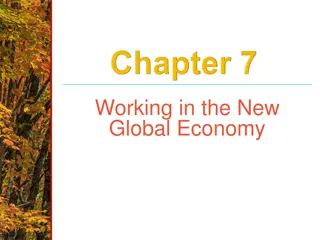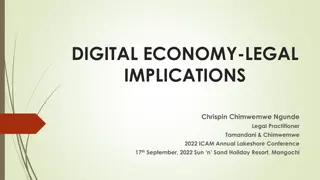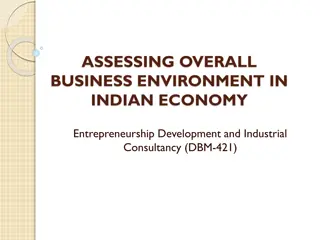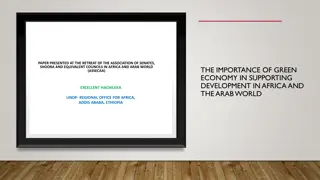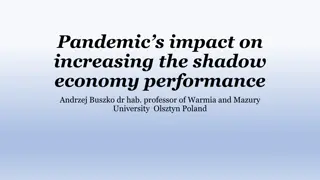Challenges for the Global Economy
Emerging from the global slowdown poses challenges like addressing imbalances, stabilizing the financial system, and regulating finance globally. The impact of globalization, the need for cooperation in crises, and the consequences of regulatory failures are also highlighted.
Download Presentation

Please find below an Image/Link to download the presentation.
The content on the website is provided AS IS for your information and personal use only. It may not be sold, licensed, or shared on other websites without obtaining consent from the author.If you encounter any issues during the download, it is possible that the publisher has removed the file from their server.
You are allowed to download the files provided on this website for personal or commercial use, subject to the condition that they are used lawfully. All files are the property of their respective owners.
The content on the website is provided AS IS for your information and personal use only. It may not be sold, licensed, or shared on other websites without obtaining consent from the author.
E N D
Presentation Transcript
GENDER-BASED VIOLENCE IN SOUTH AFRICA: INSIGHTS FROM GEOGRAPHY Paula Meth University of Sheffield ARI, London 8 October 2014 With thanks to Dr Tamlynn Fleetwood and Mrs Sibongile Buthelezi for RA work in Durban, SA (pilot project), June / July 2013).
Gender-based violence: statistics Sub-Saharan Africa (Southern): prevalence of intimate partner violence = 29.67 [7 out of 21 regions in the world have higher rates than this] (WHO, 2013: 47) Sub-Saharan Africa (Southern): prevalence of non-partner sexual violence = 17.41 [2ndhighest in world, after central Sub- Saharan Africa @ 21.05]. (WHO, 2013: 48) Jewkes et al s 2009 report: In SA: 1999: 3800 female homicides, overall female homicide rate (24.7 per 100 000) six times higher than the global average (4.2 per 100 000) 28% of men reported having perpetrated rape Men are also rape victims, about one in 30 men (3.5%) has been raped by a man rate of violent death for men (113 per 100 000) is eight times the global average (8.2 per 100 000) This crisis requires a multi-disciplinary approach to understanding causes, realities and interventions
Home is an overlooked site of violence Violence in cities: within public and private space. Gender violence evident in multiple public spaces (streets, bush , shared toilets etc. Shaped by infrastructure, lighting, policing, density) Private sphere of home = key & shaped by housing type Multiple research projects focusing on women, men and the home and violence between 2002 2014/5. Gender & civil violence and its relationship to informal and insecure housing Focused on men and women s experiences (domestic violence but also civil violence which spills into the home) 2013-2015: violence in areas where housing upgrading has occurred (where squatter camps have been transformed into formal housing) = key policy intervention in South Africa
3 key findings 1. work on domestic violence and the solutions to DV is oriented towards women living in formal housing. 2. work on gender violence overlooks men s experiences of violence in the home 3. Recent efforts to formalise squatter housing assumes social progress (crime reduction )
1. DV in informal contexts is poorly understood Lack of understanding of what it means to be a victim when you re living insecurely / informally. Lack of ownership, assets, locks, walls, privacy Global literature on DV assumes that safe houses / refuges are appropriate in response to DV But in contexts of informality, residents lack access to normal housing, let alone refuges. State s lack capacity to provide housing let alone refuges. Women manage DV in these very insecure contexts Yet, home ownership patterns, security strategies etc. are seriously challenged when living informally.
2. Mens & violence in the home Men s experiences overlooked, as perpetrators but also victims. Critical for our understanding of masculinity, men s relationship / role in their family & society Cities are areas where men suffer emotionally as a result of violence, yet we fail to address this social reality The[re are] cases of the criminals enter in your house sleep with your wife in front of you and also the children. I don t know I can survive under that situation as a head of the household. The family can not trust [that they] are protected if they with you, as [a] man you lost the dignity. No one can respect you as a man (Bongani, 2007).
3. Housing formalisation impacts on DV Positive gains: security, identity, privacy, space & shelter gains All gains can reduce tensions leading to DV. But formalisation can foster & hide DV too We have got the street light, even the passages are clear to walk [along], even at night. ..there is no place for criminals to hide. All people who live in this area belong to this area . (FG , 2011) Integrated lock on gate
Tension & competing claims to assets The housing offer is a one-off & waiting times are > 10 years. Women reporting new forms of violence (usually from male relatives) wanting to claim ownership of new housing assets. The violence I experience now is that my brother beat my daughter The house I received in 2005 I gave it to my mother because that time I was not married My brother beat my mother because he wants to take the house. When my mother passed away, the house was left with my daughter and he starts to beat my daughter and he said the house is for his mother. The case is in the court (FG1, 2013) B hre (2007) argues that conflict & violence are at the heart of urban development in SA, often relating to tensions over scarce resources. I argue that this is also gendered.
Injustices hidden in new housing Material changes: Domestic violence is hidden through better built form, more privacy, less sound travelling. Informal housing materials means neighbours CAN hear. Formal housing reinforces the silences of domestic violence. If there is misunderstanding for partners in the house they close the room and talk not in front of the children, and neighbours will not hear anything (FG1, 2013). it is changed because at mjondolo people were crowded and if anything happen was easy to spread to everybody. .. If you are sitting in your [RDP house] no one will know your problems (FG2, 2013)
Formal housing, men & alcohol men still felt they had inadequate privacy & lacked complete safety. Parenting was however easier: In the shacks: we were living with good and bad people and it was crowded, children were getting confused by different people (Felokwakhe 2011) Positive impact on identity: the status has changed. People who looked down on us, they asked now to come and find them the place to live (Bongani, 2011). Changing cities also brings changing social practices: divergent approaches to alcohol ..when a person is intoxicated unfortunately the person closest to them is the one that bears the brunt of their fury. I will say liquor is about the main cause of domestic violence. (Interview Captain Khan, 2013)
Concluding comments Understanding gender & violence requires input from multiple disciplines (legal, economic, political, sociological etc). From the perspective of geography: Civil & domestic violence are social concerns that play out in urban spaces: home, streets, work, drinking spaces etc. The home environment is a key site of violence, both intimate and stranger . Strong evidence that improvements in employment and justice mechanisms are likely to reduce women s risks of violence Interventions in African cities need an awareness of gender inequalities, and women & men s vulnerabilities












